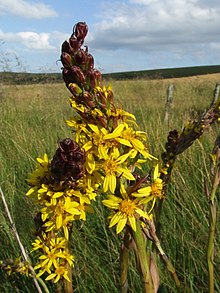| Ligularia | |
|---|---|

| |
| Ligularia sibirica | |
| Scientific classification | |
| Kingdom: | Plantae |
| Clade: | Tracheophytes |
| Clade: | Angiosperms |
| Clade: | Eudicots |
| Clade: | Asterids |
| Order: | Asterales |
| Family: | Asteraceae |
| Subfamily: | Asteroideae |
| Tribe: | Senecioneae |
| Genus: | Ligularia Cass. 1816, conserved name, not Duval 1809 (Saxifragaceae)[1] |
| Type species | |
| L. sibirica | |
| Synonyms[2] | |
| |

Ligularia (leopard plant) is a genus of Old World herbaceous perennial plants in the groundsel tribe within the sunflower family.[3] They have yellow or orange composite flower heads with brown or yellow central disc florets, and are native to damp habitats mostly in central and eastern Asia, with a few species from Europe.[4] There are about 120[5] to 140 species in the genus, and over half are endemic to China.[6] The name Ligularia, from the Latin for "strap", refers to the shape of the ray florets.[7]
Some species and cultivars are cultivated as ornamentals. Ligularia dentata ‘Britt Marie Crawford’[8] Ligularia x hessei (Ligularia dentata x Ligularia wilsoniana) 'Gregynog Gold'[9] and Ligularia przewalskii 'The Rocket'[10] have gained the Royal Horticultural Society's Award of Garden Merit.[11] They are best grown in fertile, moist soil and full sun, with some shade at midday.[citation needed]
- Species[2]
- Ligularia abakanica
- Ligularia achyrotricha
- Ligularia afghanica
- Ligularia alatipes
- Ligularia alpigena
- Ligularia altaica
- Ligularia alticola
- Ligularia altissima
- Ligularia amplexicaulis
- Ligularia angusta
- Ligularia anoleuca
- Ligularia atkinsonii
- Ligularia atroviolacea
- Ligularia biceps
- Ligularia botryodes
- Ligularia brassicoides
- Ligularia bucovinensis
- Ligularia cacaliiformis
- Ligularia caloxantha
- Ligularia calthifolia
- Ligularia carpatica
- Ligularia chalybea
- Ligularia chekiangensis
- Ligularia chimiliensis
- Ligularia confertiflora
- Ligularia coreana
- Ligularia cremanthodioides
- Ligularia cuneata
- Ligularia curvisquama
- Ligularia cyathiceps
- Ligularia cymbulifera
- Ligularia cymosa
- Ligularia dentata
- Ligularia dictyoneura
- Ligularia discoidea
- Ligularia dolichobotrys
- Ligularia duciformis
- Ligularia dux
- Ligularia eriocaulis
- Ligularia euryphylla
- Ligularia fangiana
- Ligularia fargesii
- Ligularia fauriei
- Ligularia fischeri
- Ligularia franchetiana
- Ligularia ghatsukupa
- Ligularia glauca
- Ligularia heterophylla
- Ligularia hodgsonii
- Ligularia hookeri
- Ligularia hopeiensis
- Ligularia ianthochaeta
- Ligularia intermedia
- Ligularia jacquemontiana
- Ligularia jaluensis
- Ligularia jamesii
- Ligularia japonica
- Ligularia kaialpina
- Ligularia kanaitzensis
- Ligularia kangtingensis
- Ligularia karataviensis
- Ligularia kareliniana
- Ligularia kingiana
- Ligularia knorringiana
- Ligularia kojimae
- Ligularia konkalingensis
- Ligularia lamarum
- Ligularia lanipes
- Ligularia lankongensis
- Ligularia lapathifolia
- Ligularia latihastata
- Ligularia latipes
- Ligularia leveillei
- Ligularia liatroides
- Ligularia lidjiangensis
- Ligularia limprichtii
- Ligularia lingiana
- Ligularia longifolia
- Ligularia longihastata
- Ligularia macrodonta
- Ligularia macrophylla
- Ligularia melanocephala
- Ligularia melanothyrsa
- Ligularia microcardia
- Ligularia microcephala
- Ligularia mongolica
- Ligularia muliensis
- Ligularia myriocephala
- Ligularia nanchuanica
- Ligularia narynensis
- Ligularia nelumbifolia
- Ligularia nyingchiensis
- Ligularia odontomanes
- Ligularia oligonema
- Ligularia pachycarpa
- Ligularia palmatifida
- Ligularia paradoxa
- Ligularia parvifolia
- Ligularia pavlovii
- Ligularia persica
- Ligularia petelotii
- Ligularia petiolaris
- Ligularia phoenicochaeta
- Ligularia phyllocolea
- Ligularia platyglossa
- Ligularia pleurocaulis
- Ligularia potaninii
- Ligularia przewalskii
- Ligularia pterodonta
- Ligularia purdomii
- Ligularia pyrifolia
- Ligularia retusa
- Ligularia robusta
- Ligularia rockiana
- Ligularia ruficoma
- Ligularia rumicifolia
- Ligularia sachalinensis
- Ligularia sagitta
- Ligularia schizopetala
- Ligularia schmidtii
- Ligularia sibirica
- Ligularia sichotensis
- Ligularia songarica
- Ligularia splendens
- Ligularia stenocephala
- Ligularia stenoglossa
- Ligularia subsagittata
- Ligularia subspicata
- Ligularia talassica
- Ligularia tenuicaulis
- Ligularia tenuipes
- Ligularia thomsonii
- Ligularia thyrsoidea
- Ligularia tissulaginea
- Ligularia tongkyukensis
- Ligularia tongolensis
- Ligularia transversifolia
- Ligularia trichocephala
- Ligularia tsangchanensis
- Ligularia veitchiana
- Ligularia vellerea
- Ligularia villosa
- Ligularia virgaurea
- Ligularia vorobievii
- Ligularia wilsoniana
- Ligularia xanthotricha
- Ligularia yoshizoeana
- Ligularia yunnanensis
- Ligularia zhouquensis

- ^ Tropicos search for Ligularia
- ^ a b Flann, C (ed) 2009+ Global Compositae Checklist Archived 2014-11-06 at archive.today
- ^
 This article incorporates text from this source, which is in the public domain. Porter, Noah, ed. (1913). Webster's Dictionary. Springfield, Massachusetts: C. & G. Merriam Co.
This article incorporates text from this source, which is in the public domain. Porter, Noah, ed. (1913). Webster's Dictionary. Springfield, Massachusetts: C. & G. Merriam Co. {{cite encyclopedia}}: Missing or empty|title=(help) - ^ RHS A-Z Encyclopedia of Garden Plants. United Kingdom: Dorling Kindersley. 2008. p. 1136. ISBN 978-1405332965.
- ^ Liu, J. Q., et al. (2006). Radiation and diversification within the Ligularia–Cremanthodium–Parasenecio complex (Asteraceae) triggered by uplift of the Qinghai-Tibetan Plateau. Molecular Phylogenetics and Evolution 38(1) 31-49.
- ^ Flora of China Vol. 20-21 Page 376 橐吾属 tuo wu shu Ligularia Cass. .
- ^ Coombes, A. J. (2012). The A to Z of Plant Names. USA: Timber Press. pp. 312. ISBN 9781604691962.
- ^ "RHS Plantfinder - Ligularia 'Britt Marie Crawford'". Retrieved 7 March 2018.
- ^ "RHS Plant Selector - Ligularia 'Gregynog Gold'". Retrieved 21 May 2013.
- ^ "RHS Plant Selector - Ligularia 'The Rocket'". Retrieved 21 May 2013.
- ^ "AGM Plants - Ornamental" (PDF). Royal Horticultural Society. July 2017. p. 60. Retrieved 22 March 2018.